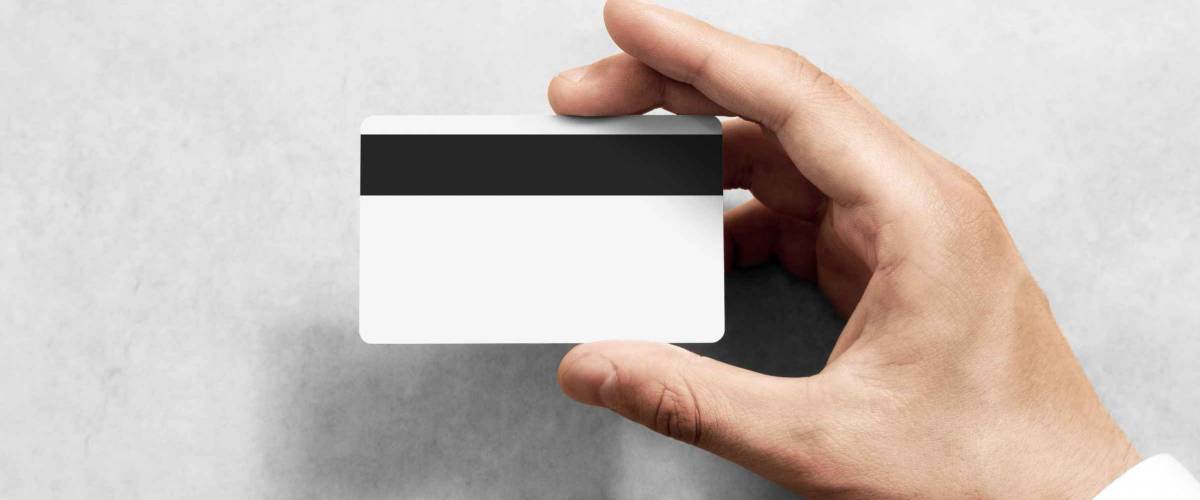The birth of the stripe

If you've been around long enough, you might remember the days before the introduction of the magnetic stripe. At one time, retailers had to write down credit card numbers by hand.
Later, credit card imprinters — machines that pressed carbon paper over the raised lettering and numbering of a physical card — created a quicker copy of payment details.
However, neither method let the merchant know whether the customer actually had the funds to pay for the purchase. In those days, credit card issuers had to send out a list of bad numbers that stores could reference.
With the arrival of magnetic tape in the 1960s and 1970s, banks could suddenly encode lots of information to the card. Combined with point-of-sale devices and data networks, transactions could be done instantly and accurately.
Kiss your credit card debt goodbye
Millions of Americans are struggling to crawl out of debt in the face of record-high interest rates. A personal loan offers lower interest rates and fixed payments, making it a smart choice to consolidate high-interest credit card debt. It helps save money, simplifies payments, and accelerates debt payoff. Credible is a free online service that shows you the best lending options to pay off your credit card debt fast — and save a ton in interest.
Explore better ratesThe death of the stripe

The stripe has served consumers well, but today Mastercard says removing it will improve reliability and security.
The magnetic stripe can degrade or even demagnetize over time, forcing the owner to replace the card. How many times have you seen someone unsuccessfully swiping their card over and over at the cash register when you're trying to pay for groceries and go home?
It’s also not very secure. Industrious thieves have long used tiny “skimmers” that can be placed inside legitimate payment terminals to harvest your data. That information can be used to commit fraud or even clone your card for their personal use.
Today, there’s a safer alternative: the “chip.”
Formally called EMV chips — for Europay, Mastercard and Visa, who originally developed the standard — this technology creates a unique one-time code with each transaction that must be instantly verified with the bank that issued the card.
While the magnetic stripe was the gold standard for the last half-century or so, chips have been found on quality credit cards for at least the last decade.
Why you won’t miss it

It seems very few people will mourn the stripe.
Only 11% of cardholders want to hang on to their striped cards, according to polls commissioned by Mastercard.
And 92% said they would keep or increase their use of the card once the stripe is gone.
The reality is that people have already been making the transition on their own. Worldwide, the chip is now responsible for 86% of all face-to-face card-based transactions, though the United States lags behind a bit at 73%.
Kiss your credit card debt goodbye
Millions of Americans are struggling to crawl out of debt in the face of record-high interest rates. A personal loan offers lower interest rates and fixed payments, making it a smart choice to consolidate high-interest credit card debt. It helps save money, simplifies payments, and accelerates debt payoff. Credible is a free online service that shows you the best lending options to pay off your credit card debt fast — and save a ton in interest.
Explore better ratesHow to keep your finances secure

Keeping your credit card info private is essential for protecting your bank account as well as your credit score. You don’t want crooks borrowing money in your name, then skipping out on the bills.
While it’s theoretically possible to steal your data through a chip or even a “tap” transaction, the more likely threat is someone skimming your stripe at the same time.
Until your provider goes stripeless, be mindful of where you swipe or insert your card. Federal law means you can’t be liable for more than $50 in fraud, but sorting that out and reversing the damage to your credit report can be a massive headache.
Sadly, chips don’t provide any additional protection when you’re shopping online. For that, you’ll need to set up a virtual credit card.
Just as a chip produces a one-time verification code, virtual credit cards generate a “burner” credit card number only temporarily linked to your real financial info.
You can install a virtual credit card in your browser for free, making it an easy way to upgrade your security in today's dangerous stripe-filled world.
This 2 minute move could knock $500/year off your car insurance in 2024
OfficialCarInsurance.com lets you compare quotes from trusted brands, such as Progressive, Allstate and GEICO to make sure you're getting the best deal.
You can switch to a more affordable auto insurance option in 2 minutes by providing some information about yourself and your vehicle and choosing from their tailor-made results. Find offers as low as $29 a month.








